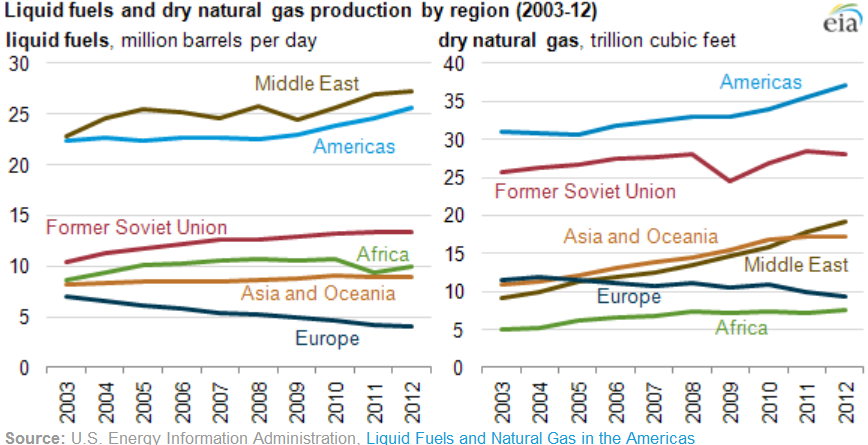
U.S. ENERGY INFORMATION ADMINISTRATION
WASHINGTON DC 20585
FOR IMMEDIATE RELEASE
January 30, 2014
The Americas are an important market for liquid fuels and natural gas trade
The Americas, which include North America, Central America, the Caribbean, and South America, account for a significant portion of global supply, demand, and trade of both liquid fuels and natural gas, according to Liquid Fuels and Natural Gas in the Americas, released today by the U.S. Energy Information Administration.
The report examines the energy trends and developments in the Americas over the past decade and focuses on liquid fuels and natural gas—particularly reserves and resources, production, consumption, trade, and investment—given their scale and significance to the region. While the report considers the region as a whole and its relationships with the rest of the world, it also discusses the principal energy-producing and consuming countries individually, based on available energy statistics.
Major conclusions of the report include:
- In 2012, the countries of the Americas were the world's second-leading producer and consumer of liquid fuels, and leading producer and consumer of natural gas. Estimates of the region's reserves and resources indicate that the Americas will continue to increase production and consumption of liquid fuels and natural gas in the future.
- Intra-American crude oil and petroleum products trade accounted for most of the total trade in the region.
- From 2003 to 2012, U.S. imports of crude oil from other countries in the region—primarily from Canada, Mexico, and Venezuela—averaged 5.01 million barrels of oil per day (bbl/d). These quantities are shifting as U.S. production continues to increase, and increased exports to China and India have started to offset decreasing U.S. imports.
- The United States has become a net exporter of petroleum products, exporting 2.0 million bbl/d to countries in the region (primarily Mexico and Canada) in 2012 compared to 0.6 million bbl/d in 2003.
- Future extraction, development, and commercialization of hydrocarbon resources in the Americas will be significantly influenced by national policies towards foreign investment. Mexico, which recently adopted new energy reforms to allow foreign private investment in the energy sector, will look to join countries with open investment structures, like Canada, Brazil, Colombia, and the United States.
- Asian investment in the region has greatly increased over the past five years, particularly investment by Chinese national oil companies in both crude oil supplies and physical assets, such as refineries.
- The Americas accounted for 20% of global natural gas trade, with imports and exports each totaling 6 trillion cubic feet (Tcf). More than 80% of natural gas trade was via pipeline to neighboring countries, with the remainder traded as liquefied natural gas (LNG). EIA expects natural gas exports from the Americas to increase as natural gas production increases, particularly in the United States. Additional LNG export terminals, along with the ongoing Panama Canal expansion, will facilitate these exports.
The full report, Liquid Fuels and Natural Gas in the Americas, is available at:
http://www.eia.gov/countries/americas/
EIA Program Contact: Michael Yo, 202-586-4058, michael.yo@eia.gov
EIA Press Contact: Jonathan Cogan, 202-586-8719, jonathan.cogan@eia.gov
EIA-2014-01

